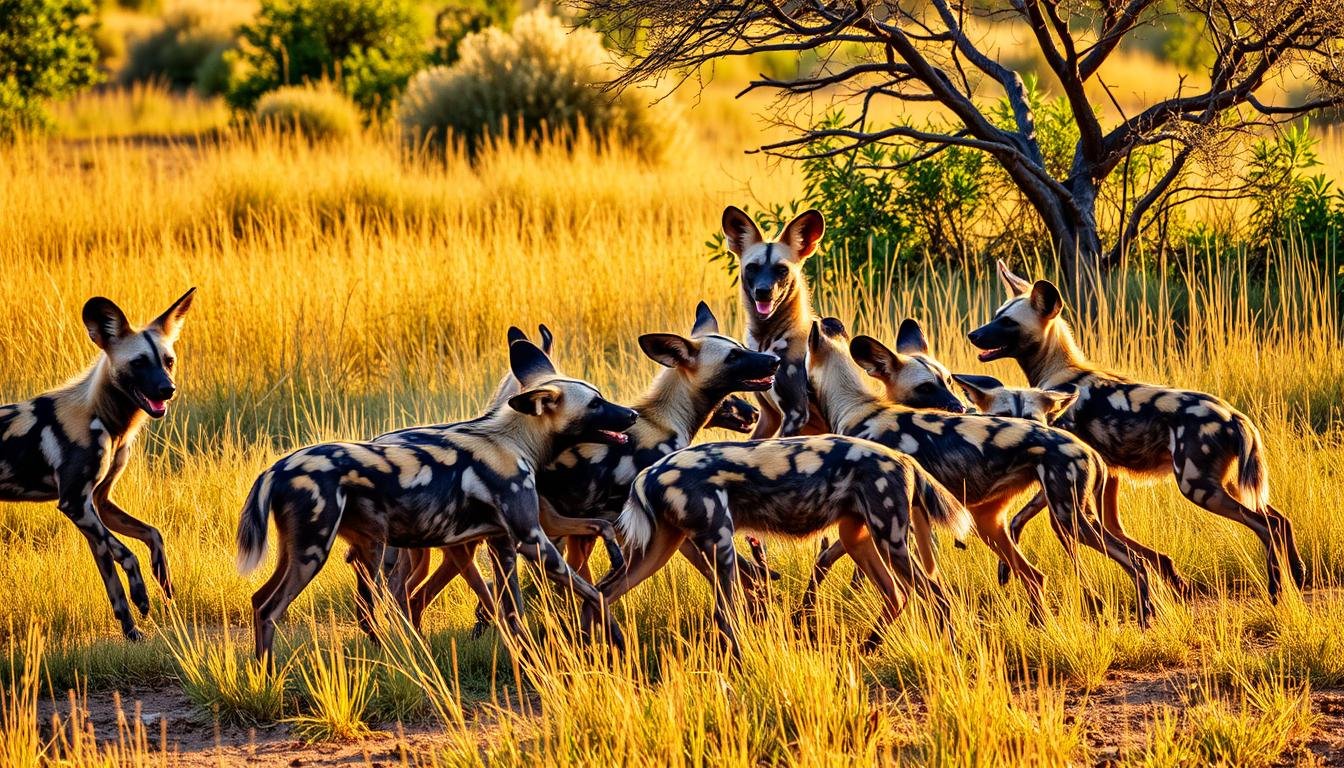African wild dogs, or painted dogs, are unique predators in sub-Saharan Africa. They’re known for their striking coats and amazing hunting skills. With only 6,600 left, these animals face big challenges in the wild.
These dogs are social and live in packs of 12 to 20 adults. They like open grasslands, woodlands, and bushveld areas. These quick hunters can run up to 44 mph.
Saving African wild dogs is very important. Their numbers have dropped from 500,000 to about 6,500 in 100 years. People are working to protect their homes and connect separated groups.
African wild dogs are great hunters. They catch their prey 80% of the time. Their prey only has a 10-30% chance to escape. This is much better than lions or hyenas.
These dogs work well together when hunting. This makes them very interesting to wildlife fans and scientists. They’re truly amazing animals to study and learn about.
Introduction to the African Wild Dog
The African wild dog is a unique canine species from sub-Saharan Africa. They are also called painted wolves or cape hunting dogs. These creatures have a distinctive look and amazing hunting skills.
Physical characteristics and appearance
African painted dogs are medium-sized canines, measuring 29.5 to 43 inches long. They weigh between 39.5 to 79 pounds. Their coats have black, white, and tan spots, with each dog having a unique pattern.
These dogs can run at speeds up to 72 km/h. This makes them excellent hunters in the wild.
Scientific classification and common names
The scientific name for the African wild dog is Lycaon pictus. They belong to the Canidae family but have 78 chromosomes. There’s evidence of ancient genetic mixing between African wild dogs and dholes.
People also call them African hunting dogs, painted hunting dogs, or painted wolves.
Distribution and habitat preferences
African wild dogs live in the open plains and sparse woodlands of sub-Saharan Africa. They like grasslands, savannas, and bushveld areas. These animals need large areas to roam freely.
You can often find them in big protected areas like Kruger National Park. The IUCN estimates there are about 6,600 adult African wild dogs left.
Social Structure and Pack Dynamics

African wild dogs live in packs with a unique social structure. These animals form tight-knit groups for survival and reproduction. They work together to ensure the pack’s success.
Pack Composition and Hierarchy
Wild dog packs usually have 6 to 12 adults and yearlings, plus pups. Some packs can grow to 30 to 50 members for short periods. An alpha pair, a dominant male and female, leads the pack.
Pack hierarchy is maintained through etiquette, not aggressive displays. This unique system helps keep peace within the group.
Breeding Patterns and Pup Care
The alpha pair typically breeds, having litters of 8 to 12 pups. All pack members help raise the pups in dens for about 4 months. Males often stay with their birth pack to help with new litters.
This cooperative breeding system ensures high pup survival rates. It’s a key factor in the pack’s success.
Communication within the Pack
Pack members use various methods to communicate. They make high-pitched calls, mark scents, and use body language. This complex system helps coordinate hunts and maintain social bonds.
| Pack Size | Litter Size | Pup Care |
|---|---|---|
| 6-12 adults | 8-12 pups | Whole pack |
| Up to 50 (temporary) | Max 21 recorded | 4 months in den |
The social structure of African wild dogs is vital for their survival. By working together, they thrive in tough environments. This teamwork helps them raise successful new generations.
Hunting Behavior and Prey Preferences
African wild dogs are incredibly efficient hunters. Their success rate averages 44% but can reach 100%. This makes them more successful than many other African carnivores.
Wild dogs hunt in packs of 7-15 members. They prefer prey weighing between 10 and 120 kg. Favorite targets include greater kudu, Thomson’s gazelle, impala, and bushbuck.
The pack often chooses slower prey. This includes young, pregnant, old, sick, or injured animals.
African wild dogs use a unique hunting strategy. Before a hunt, they gather and ‘sneeze’ to decide when to start. During the chase, they can reach speeds of 44 miles per hour.
On average, a pack makes 1.8 kills per hunt. They eat about 3.04 kg of meat daily. This is more than any other carnivore in their ecosystem.
However, wild dogs face challenges. Spotted hyenas often steal up to 50% of their kills. This behavior is called kleptoparasitism.
Despite this, wild dogs remain effective hunters. Their teamwork and stamina make them powerful predators in the African savanna.
Adaptations for Survival in African Ecosystems

African wild dogs have unique traits for thriving in harsh environments. Their physical, social, and cognitive adaptations help them survive and hunt effectively. These remarkable creatures have evolved to excel in Africa’s diverse landscapes.
Physical Adaptations for Endurance and Speed
Wild dogs can sprint at speeds up to 44 mph. Their large, circular ears help regulate body temperature in hot climates. This increases their stamina during long hunts.
A PeerJ study found wild dogs have a hidden first metacarpal. This allows for muscle changes that improve running efficiency.
Social Adaptations for Cooperative Living
African wild dogs typically live in groups of eight to 10 adults. Their social structure is crucial for survival. It allows them to take down prey much larger than themselves.
The pack’s white-tipped tail acts as a flag during hunts. This helps keep the group together and ensures coordinated attacks.
Cognitive Adaptations for Complex Hunting Strategies
These intelligent canines have developed sophisticated decision-making processes. They use a “sneezing” voting system to decide when to start hunts. Their cognitive abilities help them stay in touch while hunting.
Wild dogs can quickly adapt to changing situations. This flexibility is key to their success as hunters.
| Adaptation | Benefit |
|---|---|
| High-speed running | Efficient prey capture |
| Large ears | Temperature regulation |
| White-tipped tail | Pack coordination |
| Group living | Cooperative hunting |
| Voting system | Collective decision-making |
Conservation Status and Threats
African wild dogs are among the world’s most endangered mammals. The IUCN lists them as endangered on their Red List. Their population has dropped from 500,000 to just 6,600 mature individuals across 39 subpopulations.
Habitat loss is a major threat to African wild dogs. As humans expand, these predators lose their natural homes. This forces them closer to domestic dogs, increasing disease risks.
Rabies and canine distemper have become big problems for wild dog populations. Farmers often see them as threats to livestock, leading to killings.
These conflicts, along with habitat loss, have pushed wild dogs near extinction in many areas.
| Year | Estimated Population | Conservation Status |
|---|---|---|
| 1997 | 3,000-5,500 | Endangered |
| 2020 | 6,600 | Endangered |
| Present | ~1,400 mature individuals | Endangered |
African wild dogs remain critically endangered despite a slight population increase. Conservation efforts aim to protect their habitats and reduce conflicts. Disease control measures are also crucial for their survival.
Without these actions, these fascinating predators might vanish from the wild forever.
Role in African Ecosystems

African wild dogs are crucial for African ecosystems. As apex predators, they shape other species’ behavior and distribution. Their presence ensures a healthy and diverse environment.
Impact on Prey Populations
African wild dogs have an impressive 80% hunting success rate. This efficiency helps them manage prey numbers effectively. They target weak and sick animals, keeping prey herds healthy.
Interactions with Other Predators
These dogs compete with lions and hyenas for resources. Their pack hunting strategy helps them coexist with larger predators. This contributes to complex predator-prey dynamics in African ecosystems.
Ecological Importance
African wild dogs are vital for maintaining biodiversity. With only 6,600 left in the wild, conservation is crucial. They regulate prey populations and influence other species’ behavior.
Their presence indicates a healthy, functioning ecosystem. Conservationists aim to restore ecological balance through strategic reintroduction efforts.
- African wild dogs roam territories up to 1,500 square kilometers
- Packs typically consist of 6 to 20 dogs
- They can travel around 50 kilometers in a single day
Reintroducing African wild dogs helps preserve their unique role. These fascinating predators are essential for maintaining the delicate balance of African ecosystems.
Human-Wildlife Conflict and Coexistence
African wild dogs face challenges as their habitats shrink. They sometimes prey on livestock, leading to conflicts with farmers. Habitat loss forces wild dogs to cross farmlands, worsening the problem.
GPS collars help track wild dog movements. Six wild dogs received these collars in a recent project. This technology allows quick response if dogs approach livestock areas.
Camera traps provide valuable data on wild dog behavior. They capture information both inside and outside protected zones.
Community workshops focus on coexistence strategies to reduce conflicts. Twenty-three villages participated in discussions about living with wildlife. These workshops target key community members like livestock owners.
| Conflict Cause | Percentage |
|---|---|
| Agricultural expansion | 30% |
| Human settlement | 24% |
| Deforestation | 18% |
| Overgrazing by livestock | 14% |
| Illegal grass collection | 10% |
| Poaching | 4% |
Conservation efforts involve finding suitable locations for wild dog packs. These areas must meet habitat needs and minimize conflicts. Balancing wildlife and community needs is key to peaceful coexistence.
African Wild Dog Conservation Efforts
African wild dogs are in danger. There are fewer than 7,000 left in the wild. Protecting these unique predators and their homes is crucial.
Wildlife corridors are vital. They connect scattered groups of wild dogs. This helps maintain genetic diversity among the population.
Protected Areas and Wildlife Corridors
The African Wildlife Foundation works to protect important wildlife corridors. These corridors allow wild dogs to roam safely across large areas. This is essential for their survival.
South Africa has fewer than 550 African wild dogs left. Protecting major wildlife corridors there is crucial.
Anti-poaching Initiatives
Anti-poaching efforts are vital to save African wild dogs. The Wildlife Ranger Challenge involves over 100 teams across Africa. This shows the commitment to protecting these animals.
Rangers train hard to guard wild dogs. They protect them from poaching and accidental snaring.
Community-based Conservation Programs
Community involvement is key to successful conservation. The African Wild Dog Conservancy focuses on community projects in Kenya. They understand that wildlife and people are connected.
Educational programs help foster a sense of stewardship. For example, students are rewarded for wildlife sightings.
Partnerships also promote environmental awareness. Painted Dog Conservation and the Airports Company of Zimbabwe work together. They help protect wild dog habitats.
FAQ
What are the physical characteristics of African wild dogs?
African wild dogs weigh 44-55 pounds and stand 24-30 inches tall. They have a mottled coat of black, white, and tan. Their scientific name is Lycaon pictus.
How do African wild dogs hunt and what are their prey preferences?
African wild dogs hunt by sight during the day, using stamina to tire their prey. They have an impressive 80% hunting success rate. Their preferred prey is medium-sized antelopes like impala and springbok.
In Kruger National Park, 75% of their kills are impala. The rest consists of kudu and smaller antelope species.
What is the social structure and pack dynamics of African wild dogs?
African wild dog packs usually have 12 to 20 adult members. Some packs can grow to over 50 individuals. A dominant male and female lead the pack as the alpha pair.
The whole pack helps raise the pups. Males stay to assist with future litters. Pack members use various methods to communicate.
What are the adaptations of African wild dogs for survival in African ecosystems?
African wild dogs can reach speeds of 44 mph. They maintain high speeds over long distances. Their large ears help regulate body temperature in hot climates.
A white-tipped tail keeps the pack together during hunts. Their teamwork allows them to take down larger prey.
What is the conservation status and threats faced by African wild dogs?
African wild dogs are endangered according to the IUCN Red List. They face threats from habitat loss, human conflict, and diseases. Their population has dropped from 500,000 to about 6,600 mature individuals.
What is the role of African wild dogs in African ecosystems?
African wild dogs help maintain healthy ecosystems by targeting weak and sick prey. They compete with hyenas and lions for food. Their presence regulates prey populations and supports biodiversity.
How do African wild dogs contribute to human-wildlife conflict and coexistence?
As habitats shrink, African wild dogs sometimes prey on livestock. This leads to conflicts with farmers. Habitat loss forces wild dogs to travel through farmlands, increasing tensions.
What conservation efforts are in place for African wild dogs?
Conservation efforts focus on protecting and connecting wild dog habitats. Wildlife corridors are established to help them move safely. Anti-poaching initiatives aim to reduce illegal hunting.
Community programs educate locals about wild dogs’ importance. These efforts also provide alternative livelihoods to reduce conflicts.

















